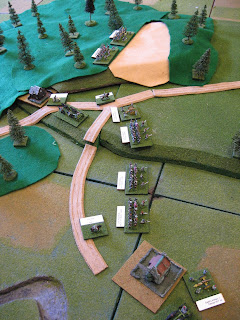The Cedar Mountain game on Sunday resulted in a (surprising to me, at least) Union victory. Although Scott, as Banks, lost half of Crawford's brigade to Confederate artillery on the approach to the Wheatfield, the remainder of Williams' division pushed Winder back from the Wheatfield with Ronald and Garnett retiring nearly one mile to the west. In the center, Banks' batteries dealt death onto Early and Taliaferro. Even in the south, the Federal battery hugging Hudson House inflicted huge casualties upon Ewell before being overrun. A.P. Hill arrived along the Culpeper Road and pushed his brigades into the fight in a piecemal fashion in an attempt to stabilize the situation. At one point, three Confederate divisions had panicked. With the arrival of darkness came Ricketts, and the game was halted with a Federal tactical victory.
5pm Deployments
Early Deploys Around Crittenden's
Deployments from SE















